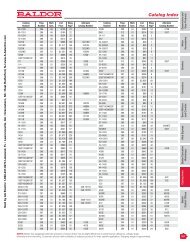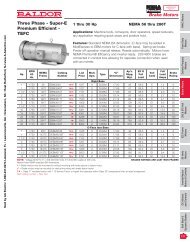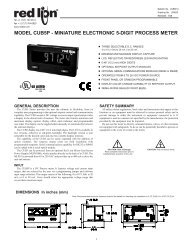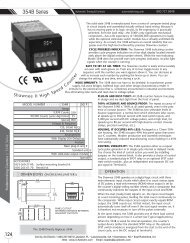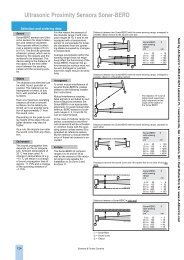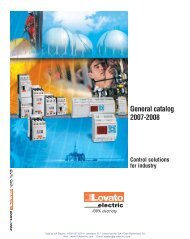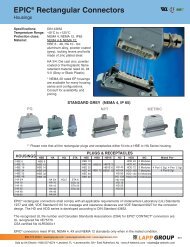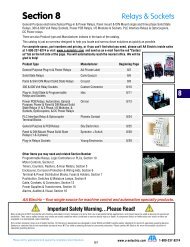You also want an ePaper? Increase the reach of your titles
YUMPU automatically turns print PDFs into web optimized ePapers that Google loves.
Technical Reference<br />
ence<br />
Terms and Definitions<br />
Accuracy: The closeness of an indication or reading of a measurement device<br />
to the actual value of the quantity being measured. Accuracy calculations are<br />
based on the linearity, hysteresis, and repeatability characteristics of the transducer/sensor<br />
and supporting electronics, the range of the transducer/sensor, as<br />
well as the resolution being displayed. It is usually expressed as a ±% of full<br />
scale output of the transducer/sensor/system.<br />
A/D (Analog to Digital): Conversion of a continuously varying signal (analog)<br />
to discrete binary numbered values (digital).<br />
Alarm Condition: The input (process signal) has crossed the set (trip) point and<br />
the relay has changed states into the alarm condition. The relay will remain in<br />
this state until the input signal returns to the normal condition.<br />
Background Noise: The total amount of noise from all sources of interference<br />
in a process loop, independent of the presence of a data/control signal.<br />
CAN (Controller Area Network): Developed by Bosch as a high speed industrial<br />
control network, but it adopted by the automotive industry for in-vehicle use.<br />
It will be mandatory on all cars by 2008. Computerization of vehicles has shifted<br />
from one engine management computer to the CAN distributed system with<br />
many interoperable computers, each having its own area of responsibility.<br />
Chatter: Describes a condition where the input signal hovers near the set (trip)<br />
point, causing the relay to trip off, then back on in short bursts. Generally solved<br />
by adding or expanding the deadband.<br />
Clipping: A phenomena that occurs when an output signal is limited in some<br />
way (usually in amplitude) by the full range of an amplifier/unit.<br />
Common-Mode Rejection (CMR): The ability of a device to eliminate the effect<br />
of AC or DC noise between the input signal and ground. Normally expressed in<br />
dB at DC to 60 Hz.<br />
D/A (Digital to Analog): Conversion of a discrete binary numbered values (digital)<br />
to a continuously varying signal (analog).<br />
Deadband: The range through which an input can be varied without initiating an<br />
observable response. Deadband is usually expressed in percent of span.<br />
Dual Alarm Trip: A unit that accepts one input signal, has two set (trip) points,<br />
and one output relay per set point. Each set point is independent of the other<br />
and can be set between 0-100% of the input range.<br />
<strong>Electric</strong>al Interference: <strong>Electric</strong>al noise induced upon the signal wires that<br />
obscures (interferes with) the wanted information signal.<br />
Fail-Safe: Relay coil is energized when the input signal is in the normal operating<br />
condition. In the alarm condition, the relay coil de-energizes. Considered a<br />
safety measure because, in the event of a loss of power to the unit or other failure,<br />
the unit “fails” to an alarm condition.<br />
Gain: The amount of amplification used in an electrical circuit.<br />
High Alarm: The relay changes state when the input signal reaches or exceeds<br />
the set (trip) point.<br />
Hysteresis: The difference in output from a transducer/sensor when a measured<br />
value is first approached with increasing and then decreasing values.<br />
Input Impedance: The total opposition, both resistive and reactive, that the unit<br />
presents to the input signal loop.<br />
Linearity: The closeness of a calibration curve to a specified straight line.<br />
Linearity is expressed as the maximum absolute deviation of any calibration<br />
point on a specified straight line during any one calibration cycle.<br />
Loop Resistance: The total resistance in a circuit to current flow caused by the<br />
resistance of all components.<br />
Loop Impedance: The total opposition (resistive plus reactive) to current flow in<br />
a circuit.<br />
Low Alarm: The relay changes state when the input signal falls to or below the<br />
set (trip) point<br />
MOV (Metal Oxide Varistor): A voltage dependent resistor whose resistance<br />
predictably changes with voltage, often used as transient protectors.<br />
Negative Temperature Coefficient: A decrease in resistance with an increase<br />
in temperature.<br />
Noise: An unwanted electrical signal on any signal wires.<br />
Non-Fail-safe (Reverse Acting): Relay coil is de-energized when the input signal<br />
is in the normal condition. In the alarm condition, the relay coil energizes.<br />
There is no alarm when there is a loss of power.<br />
Normal (Non-Alarm) Condition: The process signal has not crossed the set<br />
(trip) point.<br />
Normally Closed: Describes a set of relay contacts that, in the unpowered<br />
state, have continuity across them.<br />
Normally Open: Describes a set of relay contacts that, in the unpowered state,<br />
have no continuity across them.<br />
Optical Isolation: Two circuits that are connected only through an LED transmitter<br />
and photoelectric receiver with no electrical continuity between them.<br />
Positive Temperature Coefficient: An increase in resistance with an increase<br />
in temperature.<br />
Relay (Mechanical): An electromechanical device that completes or interrupts<br />
a circuit by physically moving electrical contacts.<br />
Relay (Solid State): A solid state switching device that completes or interrupts<br />
a circuit electrically with no moving parts. Commonly called an SSR.<br />
Repeatability: The ability of a transducer/sensor to reproduce output readings<br />
when the same measured value is applied to it consecutively.<br />
Reset: The action of returning to the normal (non-alarm) condition.<br />
Resistance: Opposition to current flow offered by a purely resistive component,<br />
measured in ohms.<br />
Response Time: The time required by a sensor to reach 63.2% of its final value<br />
in response to a step-change input. This is typically called “one time constant”.<br />
Five time constants are required for the sensor to approach 100% of the step<br />
change value.<br />
Root Mean Square (RMS): Square root of the mean of the square of the signal<br />
taken during one full cycle.<br />
Sensitivity: The minimum change in input signal to which an instrument/sensor<br />
can respond.<br />
Set Point: The point at which an alarm/controller is set to control a system.<br />
Single Alarm Trip: A unit that accepts one input signal, has one set (trip) point,<br />
and one output relay. The set point can be set between 0-100% of the input<br />
range.<br />
Span: The difference between the upper and lower limits of a range expressed<br />
in the same units as the range.<br />
Span Adjustment: The ability to adjust the gain of a sensor/unit so that the output<br />
signal corresponds to the maximum input signal. The adjustment range is<br />
normally expressed in counts or percentage.<br />
Transducer: A device that converts energy from one form to another. This term<br />
is generally applied to devices that take physical phenomenon (pressure, temperature,<br />
humidity, flow, etc.) and convert it to an electrical signal.<br />
Triac: A solid state switching device used to control alternating current.<br />
Trip Point: Value at which the alarm relays change to the alarm condition.<br />
True RMS: The true root-mean-square value of an AC or AC-plus-DC signal, for<br />
a perfect sine wave the RMS value is 1.11072 times the rectified average value.<br />
This value is often used to determine the power of a signal. For significantly nonsinusoidal<br />
signals a true RMS converter is required.<br />
Volt: The unit of potential difference and electromotive force. One volt will send<br />
a current of one ampere through a resistance of one Ohm.<br />
Voltage: The electrical potential difference that exists between two points and is<br />
capable of producing a flow of current when a closed circuit is connected<br />
between the two points.<br />
Zero Adjustment: The ability to adjust the output from a sensor/unit so that the<br />
minimum output corresponds to the minimum input. The adjustment range is<br />
normally expressed in counts or percentage.<br />
BSOLUTE ROCESS NSTRUMENTS, Inc.<br />
© Absolute Process Instruments, Inc. 11/04<br />
Sold by <strong>AA</strong> <strong>Electric</strong> 1-800-237-8274 Lakeland, FL • Lawrenceville, GA • Greensboro, NC • East Rutherford, NJ www.A-Aelectric.com



